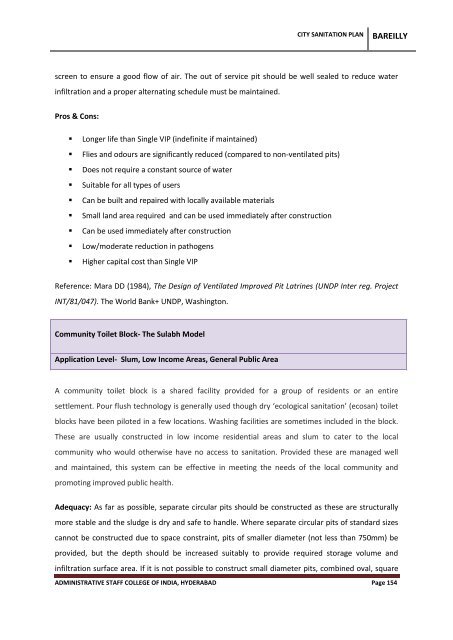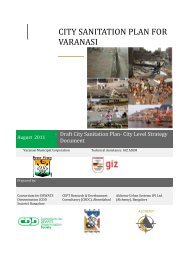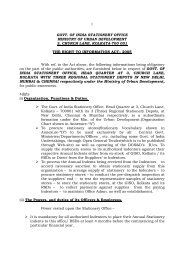CITY SANITATION PLAN - Ministry of Urban Development
CITY SANITATION PLAN - Ministry of Urban Development
CITY SANITATION PLAN - Ministry of Urban Development
Create successful ePaper yourself
Turn your PDF publications into a flip-book with our unique Google optimized e-Paper software.
<strong>CITY</strong> <strong>SANITATION</strong> <strong>PLAN</strong> BAREILLY<br />
screen to ensure a good flow <strong>of</strong> air. The out <strong>of</strong> service pit should be well sealed to reduce water<br />
infiltration and a proper alternating schedule must be maintained.<br />
Pros & Cons:<br />
Longer life than Single VIP (indefinite if maintained)<br />
Flies and odours are significantly reduced (compared to non-ventilated pits)<br />
Does not require a constant source <strong>of</strong> water<br />
Suitable for all types <strong>of</strong> users<br />
Can be built and repaired with locally available materials<br />
Small land area required and can be used immediately after construction<br />
Can be used immediately after construction<br />
Low/moderate reduction in pathogens<br />
Higher capital cost than Single VIP<br />
Reference: Mara DD (1984), The Design <strong>of</strong> Ventilated Improved Pit Latrines (UNDP Inter reg. Project<br />
INT/81/047). The World Bank+ UNDP, Washington.<br />
Community Toilet Block- The Sulabh Model<br />
Application Level- Slum, Low Income Areas, General Public Area<br />
A community toilet block is a shared facility provided for a group <strong>of</strong> residents or an entire<br />
settlement. Pour flush technology is generally used though dry ‘ecological sanitation’ (ecosan) toilet<br />
blocks have been piloted in a few locations. Washing facilities are sometimes included in the block.<br />
These are usually constructed in low income residential areas and slum to cater to the local<br />
community who would otherwise have no access to sanitation. Provided these are managed well<br />
and maintained, this system can be effective in meeting the needs <strong>of</strong> the local community and<br />
promoting improved public health.<br />
Adequacy: As far as possible, separate circular pits should be constructed as these are structurally<br />
more stable and the sludge is dry and safe to handle. Where separate circular pits <strong>of</strong> standard sizes<br />
cannot be constructed due to space constraint, pits <strong>of</strong> smaller diameter (not less than 750mm) be<br />
provided, but the depth should be increased suitably to provide required storage volume and<br />
infiltration surface area. If it is not possible to construct small diameter pits, combined oval, square<br />
ADMINISTRATIVE STAFF COLLEGE OF INDIA, HYDERABAD Page 154
















